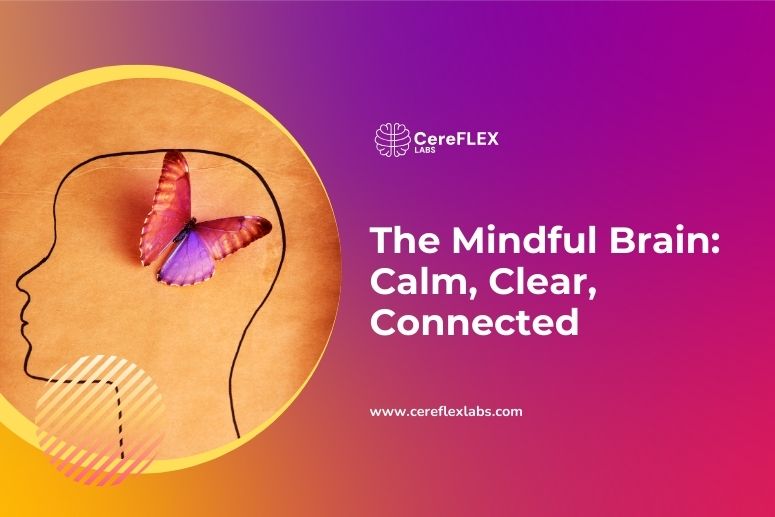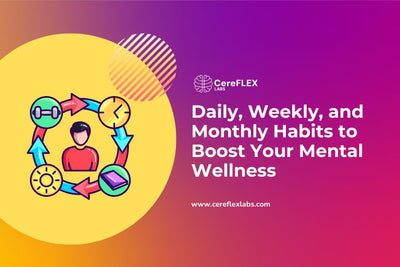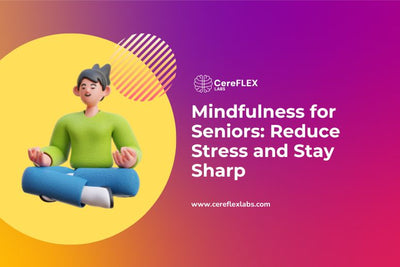The brain is always adapting. But with constant stress, distractions, and digital overload, our mental clarity can feel like it’s slipping away.
Mindfulness offers a way to slow down, refocus, and give the brain space to reset. It doesn’t take hours—just a few minutes of intentional awareness can make a measurable difference.
Research shows mindfulness improves memory, sharpens focus, regulates emotions, and protects long-term brain health. It impacts key brain regions tied to learning, stress response, and executive thinking—making it more than just a feel-good trend.
Today, mindfulness is emerging as a powerful tool for anyone—whether you’re optimizing performance, recovering from burnout, or supporting healthy brain aging.

What is mindfulness?
Mindfulness is the practice of paying attention to the present moment, intentionally and without judgment. It’s one of the most effective daily habits for brain health you can build into your life.
You don’t need to sit cross-legged or meditate for hours. Mindfulness can be practiced during everyday activities—while cooking, walking, or even doing the dishes—simply by tuning in to your breath, body, and senses.
The mind constantly scans for problems, jumps between thoughts, and seeks distractions. Left unchecked, this mental noise can lead to overwhelm and emotional fatigue.
Mindfulness teaches you to observe your thoughts with curiosity, not criticism. Over time, this practice helps create space between stimulus and reaction, calming the mind and reducing reactivity.
Eventually, you may experience moments of full presence—where you’re not lost in the past or future, but grounded in the now. That’s where the brain begins to reset and real healing can happen.
How Mindfulness Affects the Brain
Mindfulness isn’t just a feel-good practice—it produces measurable changes in brain function and structure. These changes improve how we regulate emotions, store memories, and make decisions.
Neuroplasticity and Brain Rewiring
Neuroplasticity is the brain’s ability to form new connections and reorganize itself. This process supports learning, healing, and adaptation throughout life.
Mindfulness strengthens neuroplasticity by training attention and encouraging better communication between brain regions. Over time, consistent practice improves focus, emotional regulation, and stress resilience.
Key brain areas affected by mindfulness include:
- Prefrontal cortex: decision-making and attention
- Amygdala: emotion processing and fear response
-
Hippocampus: memory formation and emotional balance
Amygdala–Prefrontal Connectivity and Emotion Control
Research shows that mindfulness practices—especially attention-to-breath (ATB) meditation—help regulate emotional responses. ATB reduces activity in the amygdala, which is tied to stress and negative emotions.
At the same time, it increases activation in the left dorso-medial prefrontal cortex, the area responsible for self-awareness and emotional control. This stronger communication between regions helps build emotional resilience.
Mindful individuals show enhanced amygdala–prefrontal connectivity, which supports clearer thinking and calmer reactions in high-stress situations.1
Strengthening the Hippocampus Through Mindfulness
An eight-week Mindfulness-Based Stress Reduction (MBSR) program was found to increase gray matter density in the left hippocampus.
Since the hippocampus plays a key role in memory, learning, and emotion regulation, this structural change suggests mindfulness enhances core cognitive functions.2
In short: Mindfulness supports hippocampal growth, which may improve memory and emotional balance.
Mindfulness and Neurogenesis
Emerging research suggests mindfulness may promote neurogenesis—the formation of new brain cells—in regions like the hippocampus.
By encouraging new neural growth and reducing the harmful effects of stress, mindfulness may help slow brain aging and support long-term cognitive health.
Proven Benefits of Mindfulness for Brain Health
Mindfulness does more than relax you—it actively enhances brain performance and emotional well-being. These changes are visible in brain scans and consistently supported by real-world studies across different age groups and lifestyles.

Reduced Stress Levels
Regular mindfulness practice helps regulate cortisol—the body’s main stress hormone—and prevents emotional exhaustion. This is especially beneficial when recovering from brain fatigue.
A global study of over 16,000 participants across 130 countries found that participants who completed a six-week online mindfulness program reported significantly reduced stress levels. The study also showed measurable improvements in mindfulness after consistent practice.3
Better Emotional Regulation and Lower Anxiety
In a randomized controlled trial, individuals with generalized anxiety disorder participated in either an eight-week mindfulness-based stress reduction (MBSR) program or a stress education course.
Both groups showed reduced anxiety, but MBSR participants experienced greater improvements on several secondary outcomes, including stress reactivity and self-reported anxiety measures.4
Slower Brain Aging and Cognitive Decline
Mindfulness may help preserve cognitive function, particularly in older adults when combined with healthy lifestyle habits.
A review of 12 studies, including controlled trials, showed early evidence that mindfulness meditation improves attention, memory, processing speed, and general cognition in aging populations.
While more research is needed, these results point to mindfulness as a low-risk, practical tool for slowing cognitive decline.5
Improved Memory and Focus
Mindfulness enhances working memory and attention—two essential components of learning and productivity.
In multiple studies, participants who practiced mindful attention performed better on memory tasks, including recall and recognition. Even brief sessions improved episodic memory, likely due to increased focus and intrinsic motivation.6
How to Start a Mindfulness Practice
You don’t need a quiet retreat or hours of free time to begin practicing mindfulness. The key is building small, consistent moments of awareness into your day.
Even just a few minutes can help reset your mental state and support brain health over time.
Here are three simple ways to get started:
Breathwork (2-Minute Practice)
Sit comfortably. Breathe in deeply through your nose for four seconds, hold for four, and exhale through your mouth for six seconds.
Repeat for two minutes, focusing only on your breath. If your mind drifts, gently return your attention to your breathing.
Body Scan
Lie down or sit still. Bring awareness to your body, starting at your toes and moving upward through each part—feet, legs, hips, torso, arms, and head.
Notice sensations without trying to change them. This practice builds bodily awareness and reduces tension.
Basic Mindfulness Meditation
Set a timer for 5 to 10 minutes. Sit quietly and focus on your breath, sounds, or bodily sensations.
When your mind wanders, gently bring your focus back without judgment. Over time, this helps you stay more grounded in the present.

How long does it take for mindfulness to change the brain?
Mindfulness doesn’t require years to make a difference. Studies using MRI scans show that regular practice can begin to change the brain in as little as eight weeks.
During this period, researchers have observed:
- Increased gray matter in the hippocampus, which supports learning and memory
- Reduced size and reactivity of the amygdala, the brain’s stress and emotion centre
Most benefits are seen when mindfulness is practiced consistently for 10 to 20 minutes a day, several times per week. Results are stronger when combined with other healthy habits like good sleep, nutrient-rich foods, and brain-supporting supplements.
Ways to Practice Mindfulness
Mindfulness doesn’t always mean traditional meditation. It’s about bringing intentional awareness to the present moment—whether seated, moving, or engaged in daily life.
You can pair mindfulness with various forms of meditation or find a style that suits your mindset and lifestyle. The key is consistency.
Here are a few styles you can explore:
- Loving-Kindness Meditation – Cultivates compassion by silently repeating well-wishes for yourself and others.
- Guided Imagery Meditation – Uses audio prompts or mental visualization to create a calming mental space.
- Insight Meditation (Vipassana) – Focuses on observing thoughts, feelings, and sensations without attachment.
- Spiritual Meditation – Centers around connection with the divine or inner self, often used in religious or spiritual traditions.
- Prayer Bead Meditation – Involves reciting mantras or affirmations while moving through a string of beads.
-
Transcendental Meditation – A mantra-based practice involving silent repetition to reach deep relaxation.
You can also explore different postures—such as sitting, lying down, or supported poses—especially if mobility or discomfort makes traditional positions difficult.
Mindful Therapy Options
Mindfulness isn’t just for solo practice—it’s also built into many modern therapy approaches. If you're seeking guided support, these therapeutic styles blend mindfulness with structured techniques for emotional and mental healing.

Holistic Therapy
A whole-person approach that considers your background, beliefs, and environment. Sessions may include complementary methods like reiki, guided visualization, or hypnosis, depending on the therapist’s qualifications.
Cognitive Behavioral Therapy (CBT)
Focuses on recognizing and reframing unhelpful thoughts and behaviours. CBT builds awareness between thoughts, emotions, and actions—foundational to mindful awareness.
Mindfulness-Based Cognitive Therapy (MBCT)
Combines CBT with meditation to help people identify thought patterns that trigger negative moods. MBCT is especially effective in reducing relapse rates in those with recurrent depression.
Dialectical Behavioral Therapy (DBT)
DBT expands on CBT with an emphasis on mindfulness, emotional regulation, and distress tolerance. It's often used to support those with intense emotional swings or relationship challenges.
Somatic Experiencing (SE)
This body-based therapy explores how stress and trauma are stored in the nervous system. By bringing awareness to physical sensations, SE helps release built-up tension and restore emotional balance.
Ecotherapy
Connects healing with nature through practices like hiking, gardening, or outdoor meditation. It encourages sensory engagement with the environment to promote presence and reduce stress.
How Mindfulness Works with Brain Supplements
Mindfulness and brain supplements aren’t opposing strategies—they’re complementary. Together, they form a well-rounded approach to mental clarity, recovery, and long-term brain health.
Mindfulness helps regulate stress hormones, improve focus, and increase mental flexibility. But to function optimally, the brain also needs key nutrients and support systems.
This is where the CereFlex AM/PM Protocol comes in:
AM Formula: Designed to enhance memory, clarity, and focus—without overstimulation. It supports high-performance thinking during your most active hours.
PM Formula: Promotes restful sleep and brain function while you rest. This prepares the brain for regeneration and sharper performance the next day.
Practicing mindfulness daily enhances the effects of these formulas by improving your internal stress response, boosting absorption through better sleep, and strengthening neural communication.
Mindfulness + CereFlex = a smarter, more sustainable brain care routine.
For more on this synergy, explore how natural nootropics and mindfulness can work together for lasting cognitive health.
Conclusion
Mindfulness isn’t just a way to feel calmer—it’s an evidence-backed tool for building a healthier, more resilient brain.
Research shows it strengthens memory, sharpens focus, regulates emotions, and helps slow age-related cognitive decline. Over time, mindfulness changes how the brain processes stress and supports greater mental clarity.
When paired with the CereFlex AM/PM Protocol, mindfulness becomes part of a complete system for cognitive performance enhancement. While mindfulness supports awareness and emotional regulation, CereFlex provides targeted support for energy, focus, and recovery.
Together, they help you think more clearly, age more gracefully, and show up with more mental energy every day.
If you’re ready to build a brain that performs and recovers—start with mindfulness, support it with CereFlex, and give your mind the foundation it deserves.






